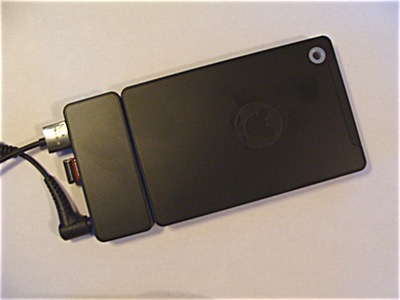- By Dan Veaner
- Business & Technology
 Print
Print  I switched from Windows to an iMac four or five years ago. But I require a few -- a very few -- Windows programs that do not have Mac versions for work. So I use a program called Parallels that runs Windows on a 'virtual machine', basically fooling part of my Mac into thinking it is a Windows computer. It works well, but it slows things down a little, and I have felt for a few years that it would be nice to have a Windows computer just for those few programs. Even with the low cost of computers these days, I couldn't justify the expense. Until Kangaroo hopped onto the scene last week.
I switched from Windows to an iMac four or five years ago. But I require a few -- a very few -- Windows programs that do not have Mac versions for work. So I use a program called Parallels that runs Windows on a 'virtual machine', basically fooling part of my Mac into thinking it is a Windows computer. It works well, but it slows things down a little, and I have felt for a few years that it would be nice to have a Windows computer just for those few programs. Even with the low cost of computers these days, I couldn't justify the expense. Until Kangaroo hopped onto the scene last week.The Kangaroo Mobile Desktop computer is a fully functional Windows 10 computer that is the same size as an iPhone 6-Plus. In fact, it is smaller, because it comes with a dock that allows you to plug in USB and HDMI devices. The whole thing, including the dock, is the same size as the iPhone 6-Plus. It is 14mm thick, somewhat thicker than an iPhone 6-Plus, but not as much as twice as thick. It fits in your pocket. You could get one from newegg.com for $99 starting October 26th. That expense for a fully functional computer is certainly justifiable.
With this caveat - it's just the computer. It doesn't include a keyboard or a mouse or a monitor. But most of us have old, spare computer stuff, and I knew I had the pieces to use this thing without spending another penny, especially since I learned Kangaroo has an iPad app called OSLINX that serves as a monitor, lets you use your finger instead of a mouse, and even has a keyboard. Not that I wanted to do all that. I had a spare Bluetooth keyboard and a USB wireless mouse, so I figured I'd use the iPad as a screen and I'd be all set.
A truly glorious plan, I thought, until the Kangaroo arrived Wednesday. It turns out that in order to use the iPad app and pair the keyboard with Bluetooth you have to have the Kangaroo hooked up to a keyboard, mouse and monitor. Becaue you need to download software for the device to work with the iPad app, and you can't pair a bluetooth device unless you are running Windows, for which you need a keyboard and a mouse.
No problem, I thought. I have an old USB keyboard in the closet, and because the Kangaroo supports HDMI monitors I can hook it up to our TV. So I moved everything to the living room, got everything hooked up, did the initial Windows 'first time' schtick, paired the keyboard, downloaded the software and hooked up the iPad. Then I shut down Windows and moved everything back to my office.
So if you don't have a spare USB keyboard and HDMI cable or USB monitor and cable you will want to borrow one for the initial setup.
 The larger section at right is the computer. The smaller piece on the left is the dock. In this picture the power supply, a USB gadget that talks to my wireless mouse, and an HDMI cable(for the monitor) is attached. The dock has room for one more USB cable. There is a fingerprint reader on one side of the computer and a Micro SD port on the other.
The larger section at right is the computer. The smaller piece on the left is the dock. In this picture the power supply, a USB gadget that talks to my wireless mouse, and an HDMI cable(for the monitor) is attached. The dock has room for one more USB cable. There is a fingerprint reader on one side of the computer and a Micro SD port on the other.The Kangaroo comes with the actual computer, the dock, and a power supply. A little booklet with type and diagrams too small to read explains what the various parts, plugs and switches do. And that's it. I downloaded a much more readable manual from the Kangaroo Web site, and followed the directions to get everything set up. But the fact is, you don't need much of a manual. Once you turn it on, it's just another Windows computer. It comes with the 64-bit version of Windows 10 Home installed with a Intel Atom x5 14nm processor and 2GB of memory. It has what the company calls a 32GB solid state drive that effectively has 28.5GB for use. That includes the space Windows needs, and any programs or data you add. It has an internal battery that is supposed to last four hours (I haven't tried it yet. It has a fingerprint reader for security. It has a slot for a Micro SD memory card for added storage, and a Micro USB receptacle. It has wifi and Bluetooth, so I was not only able to hook up that keyboard, but I can access files on our network as well as immediately having Internet access.
The dock has two USB ports -- one USB 3.0 and one USB 2.0 -- and one HDMI port. The audio is supported through the HDMI port, so it may behoove you to get a monitor with speakers, or use a small TV. The company says that it will offer docks with different features in the near future, making the Kangaroo even more versatile.
So how well does it work?
So far, so good. Subjectively, Windows 10 seems to be running faster on the Kangaroo than it does under Parallels on my Mac. I worried that it might not run a resource-intensive program I use to design Web sites as quickly as it runs on the Mac. It actually does, with no noticeable difference, except, again subjectively, it may be running slightly faster.
The Kangaroo was been designed so that it does not need a fan. The body of the computer does heat up, but not alarmingly. I, perhaps over-cautiously, leaned it against the side of a cabinet so that air is distributed on both sides. When I first started it up it was slow to recognize my Mac on the network, but it seems to have gotten over that in my second day.
I have installed two of the three programs I need to use, and with Windows and everything else a new installation of Windows includes, the 11.5GB is full, leaving 17.4GB free. That is not a lot by today's standards, but it should be plenty for my use, and for most people's use as a desktop that can be a travel computer. I should mention I am not a gamer. I would not recommend the Kangaroo for the intensive resource usage that computer games require.
I messed around a bit on HP's only somewhat helpful Web site to download the drivers needed to access our network printer. As it turned out Windows had already found and installed it. I guess things have changed since I last used Windows!
All in all I am impressed with the Kangaroo. I really didn't know what to expect in terms of performance. My wife used to use a little netbook computer, which was quite slow and disappointing in many ways. The Kangaroo is not exhibiting any of those disappointments. Granted, this is only my second day, and Windows and I haven't had time yet to add enough of our junk to slow it down. I don't travel much, but I may bring it along next time -- it will allow me to do a few things I can't do on my iPad, and it won't take much space in my luggage or add significant weight. As a secondary computer it's perfect -- it does what I need it to do, and it only cost $99.
Except that I am liking it so well I am thinking of getting a real monitor, which could easily more than double the price. Which is why I am only thinking about getting one, instead of running to the store right now.
v11i43




